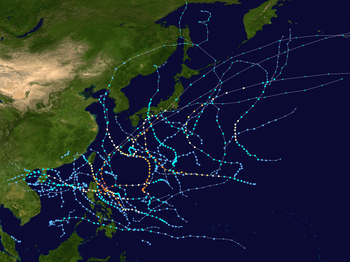Typhoon Nesat (2011)
Typhoon Nesat, known in the Philippines as Typhoon Pedring, was the most powerful tropical cyclone to directly impact China since 2005.[1] It also struck the Philippines during the 2011 Pacific typhoon season, killing 83 people.[2][3] It is the 17th named storm, the 11th severe tropical storm, the 7th typhoon and overall, the 30th tropical cyclone to be monitored by the Japan Meteorological Agency(JMA) during the year. Nesat came exactly two years after Typhoon Ketsana made landfall in the Philippines as the most devastating typhoon in the 2009 Pacific typhoon season with a damage of US$1.09 billion and 747 fatalities.[4] Nesat was also the first of twin tropical cyclones to batter the Philippines within one week during September 2011, the second was Nalgae.
| Typhoon (JMA scale) | |
|---|---|
| Category 4 typhoon (SSHWS) | |
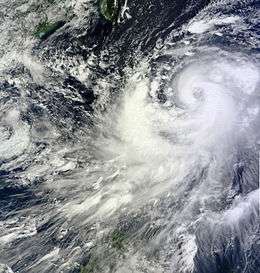 Typhoon Nesat approaching the Philippines on September 26 | |
| Formed | September 23, 2011 |
| Dissipated | September 30, 2011 |
| Highest winds | 10-minute sustained: 150 km/h (90 mph) 1-minute sustained: 215 km/h (130 mph) |
| Lowest pressure | 950 hPa (mbar); 28.05 inHg |
| Fatalities | 98 total |
| Damage | $2.12 billion (2011 USD) |
| Areas affected | Philippines, China, Hong Kong, Macau, Malaysia, Vietnam |
| Part of the 2011 Pacific typhoon season | |
The low pressure area that was to become Nesat developed on the evening of September 21, to the east-southeast of Palau. The Joint Typhoon Warning Center (JTWC) originally anticipated Nesat would become a Category 5 super typhoon on the Saffir–Simpson Hurricane Scale (SSHS) with winds exceeding 130 knots (240 km/h; 150 mph) (1-min sustained). However, because of a cold anomaly, the system only reached a maximum 1-min sustained wind speed of 115 knots (215 km/h; 135 mph) making it a powerful Category 4 typhoon. Nesat made landfall over the Luzon region of the Philippines and the maximum 1-min sustained winds dropped to 95 knots (176 km/h; 109 mph). The system continued to weaken with convective banding loosely wrapped into the partially exposed low-level circulation center(LLCC). The winds continued to drop and eventually reached 65 knots (120 km/h; 75 mph) (1-min sustained) which made it a minimal typhoon on the SSHS. On September 29, by the time Nesat managed to re-develop a 10 nautical miles (19 km; 12 mi) ragged eye, it made landfall over Wenchang in Hainan, China and started weakening again. Due to the rapid weakening, the JTWC ceased advisories on the storm, soon afterwards. Later that evening, the JMA downgraded Nesat to a tropical low over land and issued their final warning on the system.
As Nesat neared the Philippines, the local government ordered the evacuation of residents living in low-lying areas, cancelled flights and suspended classes on all levels. Several provinces were placed under Signal Number 2 and 1. China's flood control authority activated their emergency response system so that they can cope up with the upcoming typhoons Nesat, and Nalgae. The authority requested local governments in relevant areas to closely monitor both the typhoons and keep the public aware of what is happening. They initiated a level IV typhoon response program and sent two working teams to the provinces of Guangdong and Hainan so that they can assist people in all the preparations that they have to make. Ships were recalled, flight and ferry services were suspended and schools were shut as the strongest typhoon to directly impact Hainan in 2011 was approaching its final landfall. Macao's public transportation system was also suspended after typhoon signal No. 8 was hoisted by most local meteorological authorities. In Hong Kong, many functions and activities were canceled or postponed because of the fast approaching storm.
Early on September 27, Typhoon Nesat struck the Philippines with a maximum 1-min sustained wind speed of 105 knots (194 km/h; 121 mph) and killed four people after pinning them under a collapsed wall in Valenzuela. The residents of Manila had no other choice but to wade through waist-deep floodwaters, dodging branches and flying debris as the typhoon sent surging waves as tall as palm trees over seawalls, completely submerging neighborhoods. The typhoon made landfall before dawn triggering instant response. Officials in Albay province said that "About 112,000 people were ordered to leave their homes in five towns prone to flashfloods and landslides in central Albay province. Among the hardest hit provinces were Isabela and Aurora where most of the population was directly dependent on agriculture. Very similar to what happened after Typhoon Ketsana, a state of calamity was declared in Luzon in order to undertake an emergency procedure in order to ensure safe and timely water releases from the dams. Nesat approached China just one day after the preparations for it started. Because of the low strength of the storm, the damages from Nesat to China were expected to be near US$50 million. The typhoon then hit Vietnam and weakened into a tropical storm.
Meteorological history
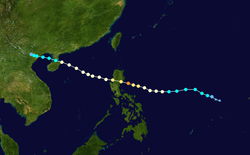
During September 21, the Joint Typhoon Warning Center (JTWC) reported that a tropical disturbance had developed at the eastern end of a monsoon trough, about 360 km (225 mi) to the southeast of Melekeok on the island of Palau.[5] The disturbance had a well defined low level circulation centre with convection flaring around it and was located in a region of moderate vertical windshear.[5] Over the next 24 hours the depression moved towards the northeast, while gradually developing further. The Japan Meteorological Agency and the JTWC then reported during September 23 that the disturbance had developed into a tropical depression, with the latter designating it as Tropical Depression 20W.[6][7]
Early on September 24, the JMA further upgraded 20W to a tropical storm and named it Nesat.[8] Nesat continued to drift west with expanding deep convection around the entire system and consolidating convection around the LLCC. The mid-level warm anomaly near the system continued to intensify and convective banding near the LLCC became more and more tighter.[9] As a result, the JMA upgraded Nesat to a severe tropical storm on September 25.[10] Nesat was originally expected to have undergone rapid intensification until September 25, but the JTWC later reported that the sea surface temperatures was a little less than expected and Nesat could not strengthen rapidly. However, Nesat was still strengthening. With an extremely well developed equatoward outflow, Nesat already had a windspeed of 75 knots (139 km/h; 86 mph) (1-min sustained).[11] Late on September 25, the JMA further upgraded Nesat to a typhoon.[12]
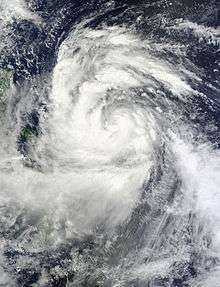
On September 26, an image from Advanced Microwave Sounding Unit (AMSU), a multi-channel microwave radiometer installed on meteorological satellites depicted that Nesat developed an eye like feature approximately 225 nautical miles (417 km; 259 mi) east-northeast of Manila, Philippines. At that time, it had a 1-min sustained wind speed of 80 knots (150 km/h; 92 mph) with deep convection primarily over the western semicircle of the system.[13] The system rapidly deepened and quickly developed a 30 nautical miles (56 km; 35 mi) ragged eye and mesoscale anticyclone aloft generating an exceptionally excellent all-around outflow. Also, the system had a highly symmetric radial outflow. The JTWC Originally anticipated Nesat to become a Category 5 super typhoon on the SSHS with winds exceeding 130 knots (240 km/h; 150 mph) (1-min sustained). However, because of a cold anomaly, the system only reached a maximum 1-min sustained wind speed of 115 knots (213 km/h; 132 mph) making it a minimum Category 4 typhoon.[14]
Early on September 27, Nesat made landfall over the Luzon region of Philippines. As a result, the eyewall got eroded and the maximum 1-min sustained winds dropped to 95 knots (176 km/h; 109 mph). The system approached land at nearly 10 knots (19 km/h; 12 mph).[15] However, later on that day, the LLCC started to get re-consolidated with convection as Nesat quickly moved west and re-emerged over water. At that time, it was located near the southern periphery of a deep layered subtropical steering ridge and moved towards the southwest and the winds further dropped to 85 knots (157 km/h; 98 mph) because of land interaction.[16] Though the system has maintained overall central deep convection, subsidence persisted along the northwest quadrant which caused further drop in wind speed. Upper level analysis indicated that Nesat was to the south of a ridge axis in an area of moderate vertical wind shear.[17] The system continued to weaken with convective banding loosely wrapped into the partially exposed LLCC. The winds continued to drop and eventually reached 65 knots (120 km/h; 75 mph) (1-min sustained) which made it a minimal typhoon on the SSHS. Though the weakening, Water vapour imagery showed that the typhoon was still maintaining excellent outflow towards the equator and improving outflow towards the pole.[18] Nesat maintained a relatively large area of gale-force winds. Animated infrared satellite imagery depicted that the storm was expanding in size and convective banding continued to move further and further away from the LLCC. The LLCC was also relatively large, elongated and cloud free.[19]
On September 29, by the time Nesat managed to re-develop a 10 nautical miles (19 km; 12 mi) ragged eye, it made landfall over Wenchang in Hainan, China and started weakening again. Because of the poor shape and disorganization at the LLCC, the typhoon could only maintain a maximum 1-min sustained windspeed of 65 knots (120 km/h; 75 mph).[20] Even after the landfall, Nesat maintained vigorous convection all around the LLCC and did not weaken too much when compared to the reactions after the Philippine landfall. There was a sea-surface temperature of approximately 28 °C (82 °F) and a slight vertical wind shear of 10 knots (19 km/h; 12 mph) near the system's center at that time. The JTWC anticipated the storm to gradually drift over the Gulf of Tonkin and make landfall over Vietnam with a 1-min sustained wind speed of at least 50 knots (93 km/h; 58 mph).[21] Early on September 30, Nesat made its final landfall over northern Vietnam with a 1-mim sustained windspeed of 55 knots (102 km/h; 63 mph) and a well-defined, tightly wrapped LLCC, and soon it started weakening. Due to land interaction, the convection around the system started decaying rapidly.[22] Due to the rapid weakening, the JTWC ceased advisories on the storm, soon afterwards.[23] Later that evening, the JMA downgraded Nesat to a tropical low over land and issued their final warning on the system.[24]
Preparations and impact
| Country | Deaths | Missing | Damage (USD) | Sources |
|---|---|---|---|---|
| Philippines | 85 | 18 | $333 million | [25][26] |
| Vietnam | 8 | $50 million | ||
| China | 5 | 2 | $1.74 billion | [27][28][29] |
| Totals | 98 | 20 | $2.12 billion |
Philippines
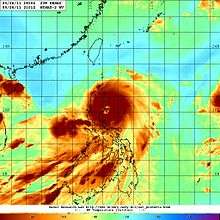
As Nesat neared the Philippines, the Philippine government ordered the evacuation of residents living in low-lying areas, cancelled flights and suspended classes on all levels. By the morning of September 26, some 111,000 people in the flood-prone areas of the Albay Province were ordered to leave their homes. Nearly 63 flights were either delayed or cancelled due to the storm.[30] The provinces of Albay, Catanduanes and the Camarines were placed under storm warning Signal Number 2 while the provinces of Metro Manila, Masbate, Marinduque, Batangas, Cavite, Bulacan, Pampanga and a most of the Northern Luzon provinces were placed under storm warning Signal Number 1.[31] Even though Manila was placed in Storm Signal 2 (which suspends Pre-school, Elementary, and High school levels only), many universities, like the University of the Philippines Diliman & Manila and Polytechnic University of the Philippines, Main Campus, suspended classes.
Early on September 27, Typhoon Nesat struck the Philippines with a maximum 1-min sustained wind speed of 105 knots (194 km/h; 121 mph) and killed four people after pinning them under a collapsed wall in Valenzuela.[32] The typhoon pounded the Luzon region of the Philippines triggering flash floods, cutting power and halting daily activity in the capital Manila. The Philippine Stock Exchange and US embassy were forced to close due to the strong winds and heavy rains.[33] The residents of Manila had no other choice but to wade through waist-deep floodwaters, dodging branches and flying debris as the typhoon sent surging waves as tall as palm trees over seawalls completely submerging neighborhoods. By the evening of September 27, at least 7 people were reported to be killed and most of them in metropolitan Manila, a place already battered by heavy monsoonal rains. A motorcyclist in the city reported that "It's flooded everywhere. We don’t have a place to go for shelter. Even my motorcycle got filled with water". He was one of the thousands stranded by fast-rising flood in the city.[34] Similar to Tulane University during Hurricane Katrina, the Ospital ng Maynila Medical Center moved patients from its ground floor which was flooded with neck-deep waters. Hospital generators were flooded and the building had no power once the typhoon arrived. Soldiers and police in trucks moved thousands of residents, most importantly the women and the children away from the Baseco shanty town after many houses were washed away in the storm surge and floodwaters brought by Nesat.[35] The typhoon made landfall before dawn triggering instant response. Officials in the Albay Province said that "About 112,000 people were ordered to leave their homes in five towns prone to flash floods and landslides in central Albay province. By Monday, more than 50,000 had moved to government-run evacuation centers and relatives' homes". Authorities ordered more than a hundred thousand people across the country to flee from Typhoon Nesat's rains and wind gusts. Several schools and offices were shut and thousands were stranded after flight and ferry services were completely disrupted by the fierce storm.[36]
Nearly thirty-seven percent of Manila Electric Company's service area was left without power after high winds and heavy rains toppled power lines. A company spokeswoman reported that "About 1.9 million customers of the nation's biggest power retailer are still without electricity. That's about 39 percent of its 4.9 million customers, compared with 44 percent who were without power at midday." Also, in Malabon, Navotas and Valenzuela the Manila Electric power company shut down power to prevent any accidents. Dina Lomotan, the company spokesman said that "Manila Electric will try to restore power as conditions permit, prioritizing areas not directly affected by the storm."[37] Benigno Aquino III, the 15th and current President of the Philippines said "I have been in touch with Secretaries Soliman, Gazmin, and Almendras. I have instructed the Executive Secretary to compile information from National Disaster Risk Reduction and Management Council and to inform our people of conditions as well as of government efforts to mitigate the effects of the storm." He also said "I am in constant touch with the members of my cabinet and the Executive Secretary has been instructed to keep me and the public informed of conditions pertaining as well as mitigation efforts".[38] On September 28, the death toll from Nesat was put at 18 and the number of missing at 35 after the day-long rain and winds. The National Disaster Risk Reduction and Management Council chief Benito Ramos said "We are focusing on trying to get power and telecommunications services today, and work crews have also fanned out to repair and clear 61 road networks across Luzon damaged by landslides, debris and floods". The extremely high storm surges brought by Nesat crashed over seawalls, flooding a hospital, a five-star hotel and the US embassy near Manila. As more power lines were downed, nearly a million people in Luzon and some areas in the capital Manila remained without power for the rest of September 27 and 28.[39]
Among the hardest hit provinces were Isabela and Aurora where most of the population was directly dependent on Agriculture.[40] Out of the total known deaths, most of them were reported to have occurred in and around metropolitan Manila. Santiago Austria, the mayor of Jaén, a 1st class municipality in the province of Nueva Ecija said "We only have four boats but there are so many people waiting to be rescued. Many people here are still on top of their houses. We don't have enough boats to reach them and hand them food." The strong winds that blew through Manila toppled about 40 huge trees around the coastline from where thousands of people were moved from shantytowns into three different school buildings.[41] The number of passengers stranded after Nesat's approach was as high as 4,476 in various ports 28 vessels and 20 motorized bancas were stopped at several ports in Luzon. A spokesman from the Philippine Coast Guard said that the bulk of stranded persons were stuck in ports in Manila, with 3,672; Lucena, 280; and Batangas, 140.[42] By the night of September 28, Nesat's death toll eventually rose to 31. At that time, the first figures of the total estimated damage to agriculture and infrastructure started coming up and was put at 1 billion pesos (22.8 million U.S. dollars). The Philippine Department of Health, which is the executive department of the Philippine Government responsible for ensuring access to basic public health services to all Filipinos prepared medical supplies including 2.9 million pesos (66,360 U.S. dollars) worth of food and emergency supplies so that they can be distributed among the victims when the flood water recedes.[43]
State of calamity
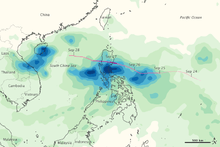
Very similar to what happened after Ketsana, a state of calamity was declared in Luzon in order to undertake an emergency procedure in order to ensure safe and timely water releases from the dams. As several thousands of people still remained without power, Alfredo Panlilio, the Meralco senior vice president and head of customer retail services and corporate communications said that "These are mostly isolated circuits, or circuits which have been badly damaged, or the restoration of which is made more difficult by obstructions like debris." Unusually, most of the rainfall from the typhoon came long after its landfall, as it moved toward the South China Sea. Only then did the residents of Cagayan Valley and Central Luzon began feeling the impact of the heavy rains it dumped. The rivers started swelling and the water in Magat Dam in Isabela province was released prompting thousands of residents to flee to high grounds and evacuation centers. Magat Dam instrumentation section chief Saturnino Tenedor said that "The reservoir level breached the 193 meters above sea level (masl) critical level by 1.71 masl on Wednesday. Seven gates of the dam were opened." 55 Villages were flooded in the capital Ilagan and several rescue teams were going around town to rescue the residents who rushed to their rooftops. The Bulacan Governor Wilhelmino Sy-Alvarado said that "The release of water from the Angat, Bustos and Ipo dams caused widespread flooding in 21 towns including Norzagaray, San Miguel, San Rafael, Bustos, Baliuag, Plaridel, Calumpit, Pulilan, Paombong and Hagonoy."[44] The Department of Social Welfare and Development (DSWD) and Philippine National Police (PNP) instantly responded to the state of emergency. The DSWD provided a total of 1.5-million Philippine Peso worth of relief goods and the PNP dispatched personnel and medical teams in order to assist the victims. The National Electrification Administration administrator Edita Bueno said that "More than 900,000 out of 1.2 million consumers were still cut off from the grid, but repairs are ongoing and electric cooperatives would have to wait for the grid's complete restoration before they could bring back electricity."[45]
NDRRMC Situation reports
Early on September 29, the National Disaster Risk Reduction and Management Council (NDRRMC) issued a Situation report on the typhoon mentioning that at least 35 people were killed while 34 were injured and 45 still remained missing. They also added that the total amount of damage to agriculture and infrastructure was put at US$26,208,476. They mentioned that a total of 83 emergency incidents were monitored in various regions that were directly hit by the typhoon. In the hardest hit provinces, at least 25 folding beds; 18 tents; 40 boxes of blankets; 125 pieces of plastic mat; 200 pieces of water jugs; 125 pieces of mosquito nets; 5 pieces of protective suits; 5 pairs of goggles; 5 pieces of oil resistant boots, 5 pieces of rain coats; 10 pieces of gloves; 5 pieces of helmets; and 10 pieces of T-shirts were provided to the victims.[46] Following the daily pattern of Situation reports, the NDRRMC issued another report on September 30, pushing up the number of dead to 43, the number of injured to 44 while pulling down the number of missing to 30. They reported that the total number of people affected were 986,417 in about 205,885 families. They also announced that there was a drastic increase in the total amount of damage from Nesat to both agriculture and infrastructure. They said that the total damage was at US$91,356,378 out of which US$78,893,835 was to agriculture alone. According to the report, the storm completely destroyed a total of 3,394 houses while 12,901 were badly damaged.[47]
Again on October 1, the NDRRMC reported the number of dead was as high as 50, the number of injured was 61 and the number of missing was 31. They further increased the total damage from Nesat to both agriculture and infrastructure to around US$136,957,559 where nearly US$123,951,792 was to agriculture alone. They said that a total of 60 bridge/road sections were reported impassable during the storm. The reports also indicated that all the transmission lines affected by the typhoon were put back to normal and power was restored completely. The NDRRMC further added that the Philippine National Police deployed a total of 87 deployed personnel in Hermosa, Bataan, Tarlac, Bulacan, and Pampanga; a total of 579 personnel deployed to help in the evacuation and rescue operations in the provinces of Aurora, Pampanga, Bulacan, Tarlac, and Angeles.[48] On October 2, the NDRRMC finalized the death toll to 52, the number of injured to 63 and the number of missing to 30. Also, they announced that the total damage to agriculture and infrastructure was amounted to US$153,316,943; making it one of the most destructive tropical cyclones ever to hit the archipelago.[49]
However, again on October 3, the NDRRMC confirmed more deaths, putting the number of dead at 85; the number of injured at 65 and the number of missing at 2. Also, they announced that Nesat was one of the costliest typhoons to have affected the nation by putting the total damage from Nesat to both agriculture and infrastructure at US$333 million.[50]
Highest Public Storm Warning Signal
| PSWS# | LUZON | VISAYAS | MINDANAO |
|---|---|---|---|
| PSWS #3 | Ilocos Norte, Ilocos Sur, Abra, Kalinga, Mt. Province, Ifugao, Benguet, La Union, Nueva Vizcaya, Pangasinan | NONE | NONE |
| PSWS #2 | Apayao, Cagayan, Isabela, Quirino, Nueva Ecija, Zambales, Pampanga, Tarlac, Bulacan, Bataan, Metro Manila | NONE | NONE |
| PSWS #1 | Babuyan Group of Islands, Calayan Group of Islands, Northern Quezon, Polillo Island, Rizal, Laguna, Batangas, Lubang Island, Cavite | NONE | NONE |
China, Malaysia and Vietnam
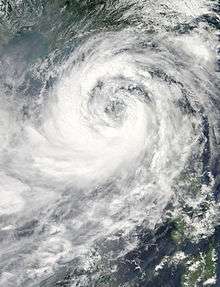
On September 28, China's flood control authority activated their emergency response system so that they can cope up with the upcoming typhoons Nesat, and Nalgae. The authority requested local governments in relevant areas to closely monitor both the typhoons and keep the public aware of what is happening. They initiated a level IV typhoon response program and sent two working teams to the provinces of Guangdong and Hainan so that they can assist people in all the preparations that they have to make.[51] The passenger ferry services linking the southern island province of Hainan and the rest of the nation were halted as typhoon Nesat neared land. Nesat was expected to be the strongest to hit Hainan in six years. The Hainan provincial meteorological bureau's director, Cai Qinbo, advised all people living in coastal areas to evacuate and also to brace for flash floods and other storm related natural disasters that Nesat may bring to the nation.[52] Ships were recalled, flight and ferry services were suspended and schools were shut as the strongest typhoon to directly impact Hainan in 2011 was approaching its final landfall. In order to ensure the safety of the children, most kindergartens, primary and middle schools in Haikou, the capital of Hainan suspended classes very early. The Meilan Airport in Haikou city canceled a total of 49 flights.[53] In all, 5 people were killed in South China.[28][29] Total economic losses in South China were amounted to be CNY 11.10971 billion (US$1.736 billion), including 2.86 billion CNY in Guangdong Province, 2.436 billion CNY in Guangxi, 5.81371 billion CNY from Hainan Province.[27][28][29]
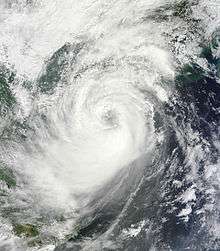
Nesat approached China just one day after the preparations for it started. On September 29, the Hong Kong Stock Exchange was shut down after the Hong Kong Observatory hoisted a number eight storm signal. The government offices and courts were also closed, delaying the widely anticipated ruling in Vallejos v. Commissioner of Registration.[54][55] The strong winds injured at least three people after Nesat slammed into the southern Chinese island of Hainan forcing more than 100,000 people to leave their homes.[56] Nesat was one of the strongest storms to strike the nation after the highest storm warning in two years was issued in Hong Kong as Typhoon Nesat swept past the city. All flights and high-speed railway services to the resort city of Sanya in Hainan were canceled or indefinitely delayed as the typhoon approached.[57] Powerful tail winds from Nesat affected areas in the west coast of Sabah on the northern part of Borneo. The winds caused power lines being knocked down causing power outages affecting 15,000 consumers. The winds also caused trees being uprooted, and roofs and billboards destroyed. State Meteorological Department recorded winds up to 95 km/h.[58] The typhoon then hit Vietnam and weakened into a tropical storm. The disaster officials in Vietnam said that "The fish and shrimp farmers had been moved to safe areas along the northern and central coasts. Some 4,000 people, mostly the elderly, women and children, were also evacuated in three coastal districts in Nam Định province."[59] The Flood and Storm Prevention and Control authority in Vietnam said that "No casualties were reported after the typhoon made landfall over the northern region of Quảng Ninh and Hai Phong yesterday afternoon, but strong winds and heavy downpours resulted in significant property losses". The initial situation reports from the hard hit Quảng Ninh Province showed that after three hours of battering, the roofs had been blown from nearly 300 houses, 11 vessels were lost and 1,700ha of subsidiary crops were submerged. At least 10 domestic flights were cancelled by Vietnam Airlines due to bad weather and nearly 4 trains between Ha Noi and Hai Phong City were delayed indefinitely. Severe flooding in the south claimed the lives of eight people in the Mekong Delta and forced thousands to leave their homes.[60] Because of the low strength of the storm, the damages from Nesat to china were expected to be near US$50 million. AIR Worldwide said that "Insurance penetration for typhoons is quite low in China, particularly for residential risks, and insurance penetration varies by province, Hainan having one of the lowest rates in China."[61] However, on October 4, the state run Xinhua News Agency confirmed that the damage exceeded 900 million United States dollars or 5.8 billion yuan as Nesat was one of the strongest typhoons to hit Hainan, affecting at least 3.77 million people.[62]
Hong Kong and Macau
In Hong Kong, many functions and activities were canceled or postponed because of the fast approaching storm. The Hong Kong's stock market, all courts, tribunals, court registries and offices were completely shut for the rest of September 29. Also, the education bureau announced suspension of all classes and the Hospital Authority suspended general out-patient and specialist clinics for the entire day too. In order to help people in need of refuge during the landfall, the city's Home Affairs Department opened 11 temporary shelters in various districts across Hong Kong.[63] Macao's public transportation system was also suspended after typhoon signal No. 8 was hoisted by most local meteorological authorities. Macao's Meteorological and Geophysical Bureau issued signal 8 while the storm was estimated to be about 350 km south of Macao at 4:00 a.m. local time. The local traffic authorities reacted in a timely manner and closed all the three sea-crossing bridges of the island city.[64] Late on September 27, the Hong Kong Observatory and the Macau Weather bureau hoisted the standby signal no.1, so that residents of the regions, could start to make preparations for the incoming typhoon. Both weather offices then issued Strong Wind Signal No. 3 later that day, before hoisting issuing the No. 8 Gale or Storm Signal on September 29 as Nesat started to affect the regions with easterly gale-force windspeeds. All signals were then lowered during September 30.[65][66] Within Hong Kong, 418 reports of fallen trees and 15 reports of collapsed scaffolding were received by the Hong Kong Observatory, with a total of 25 people injured while at the Hong Kong airport over 40 flights were cancelled due to the adverse weather associated with Nesat.
Aftermath
Typhoon Nalgae
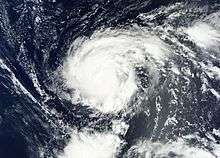
On September 30, the Americans living in Philippines were reminded by the United States government "to carry their travel documents at all times and secure them in a safe and waterproof location." The government launched the helpline numbers 1-888-407-4747 and 1-202-501-4444 so that the people traveling within the nation can obtain updated information from the Department of State.[67] Also, the PAGASA insisted all people living in the low-lying areas to leave immediately. The said that "Even areas that are currently not flooded are in danger because water from flooded communities will eventually seep into neighboring areas."[68] As preparations were underway, the president of Philippines said that "More troops and equipment from the Army, Navy and Air Force, including helicopters, have been deployed to flooded areas in Central Luzon to search and rescue affected residents". He added that the "National Disaster Risk Reduction and Management Council has been taking all necessary precautions from early warning, pre-emptive evacuation to on-going relief and recovery operations amid the onslaught of Typhoon Pedring and the anticipated effects of Typhoon Quiel over the weekend."[69] The PAGASA hoisted public storm warning signal number 3 in Cagayan and Isabela provinces as the storm drifted closer. They said that "The coming storm is expected to bring strong winds, but authorities are more concerned about the amount of rainfall it will pour." Fears worsened as the typhoon came in less than 5 days after Nesat devastated the same place and also lead to a state of calamity being declared. Five towns in Cagayan were still flooded and the same place was to be hit by Nalgae, which is much more stronger than Nesat.[70]
The Malacañan Palace called on Filipinos, especially those in Metro Manila to help each other whose properties have been devastated during the twin-typhoons Nesat and Nalgae, The Deputy presidential spokesperson Abigail Valte said "Relief and rescue workers need boats that can maneuver in flooded areas in Central Luzon, and volunteers who can help repack relief goods of the Department of Social Welfare and Development. he DSWD is repacking relief goods at its warehouse near the Ninoy Aquino International Airport. If you want to volunteer your services, you can do so. As for the wealthier Filipinos who own rubber boats or speedboats and want to lend them to our authorities, they can get in touch with the local government officials concerned."[71] The extremely strong winds blown by Nalgae set off a rockslide in northern Bontoc provincecausing boulders to roll down a mountainside and smash on a passing van, killing one man. In the rice-growing province of Bulacan north of Manila, several hundreds of people in several towns remained trapped on their rooftops as the floodwaters brought by Nesat never retreated and more flooding and rain was brought by Nalgae. Rescuers aboard rubber boats could not reach them because the alleyways were too narrow. Officials said that two army helicopters would be later deployed to rescue the victims.[72] Jay Mijares, a spokesman for the nonprofit humanitarian group, World Vision said that "The immediate need is ready-to-eat food and water. Survivors have no means to cook food. We are seeing a mass exodus of people looking for food, there is no supply, and on top of that their livelihood is disrupted. They have money but there's just nothing to buy." According to the disaster council NDRRMC, "Over the course of the weekend, the storm forced the closure of a number of bridges and made a number of roads impassable in the cities of Calasiao and Dagupan on Luzon island."[73]
The Rescue workers scrambled through the floodwaters on October 2, so that they could be able to deliver food, water and other relief materials to hundreds of villagers stuck on rooftops since several days after the twin typhoons ravaged the nation. Seven towns north of Manila including Calumpit in rice-growing Bulacan province continued to be under waist-high waters after the rains brought by Nalgae, the 17th tropical cyclone to affect the disaster-prone nation in 2011. Helicopters were able to deliver food via air, but could rescue none of those who were on the rooftops since 4 days.[74] Jay Mijares, a spokesman for the nonprofit humanitarian group, World Vision said that "The immediate need is ready-to-eat food and water. Survivors have no means to cook food. We are seeing a mass exodus of people looking for food, there is no supply, and on top of that their livelihood is disrupted. They have money but there's just nothing to buy." According to the disaster council NDRRMC, "Over the course of the weekend, the storm forced the closure of a number of bridges and made a number of roads impassable in the cities of Calasiao and Dagupan on Luzon island."[73] On October 3, Philippine authorities rushed aid to thousands of people marooned in their flooded homes for a week since Nesat and Nalgae together battered the nation. After a long time, the flood water slowly started receding and the rescue workers were able to deliver food and other relief materials to those in need. In Calumpit. one of the worst hit towns, a construction worker in line for receiving the relief materials said to a new agency, "We have no food to eat, and no clean drinking water."[75] It was later reported that at least 8 million people living in the Philippines have experience faced much worse floods than the earlier destruction caused by typhoon Nesat. The disaster management chief Benito Ramos said "The fight is not over yet. I hope the (Nesat) floods will wash out to Manila Bay before the (Nalgae) runoff hits the area. If the latter catches up to the former, there won’t be any rooftops left to see above the floodwaters." The local weather agency announced that the water levels on the tributaries of major central Luzon rivers were still continuing to rise fast and posed a threat to the nearby towns and villages.[76]
Retirement
Due to extremely high amount of damage that the storm has caused in the Philippines, the PAGASA announced that the name, Pedring would be stricken off their tropical cyclone Naming lists. In June 2012 the name Perla was chosen by PAGASA to replace Pedring for the 2015 season. However, due to the limited number of typhoons that entered Philippine area of Responsibility on that year, the name wasn't used, and instead was first used in the 2019 season.
See also
- Typhoon Son-Tinh (2012)
- Typhoon Xangsane
- Typhoon Ketsana
- Typhoon Kalmaegi (2014)
- Typhoon Nari (2013)
- Typhoon Sarika (2016)
References
- "Typhoon Nesat triggers flooding in SW China". Xinhua News Agency. Retrieved 2 October 2011.
- "Philippines starts to tidy up after Nesat". euronews. Retrieved 28 September 2011.
- "Why foreigners don't invest in Philippines". Inquirer.net. Retrieved 28 September 2011.
- "Evacuations as typhoon nears Philippines". Google News. Retrieved 26 September 2011.
- Joint Typhoon Warning Center. "Significant Tropical Weather Outlook for the Western and South Pacific Oceans 2011-09-21 15z". United States Navy, United States Airforce. Archived from the original on 2011-09-23. Retrieved 2012-03-26.
- Joint Typhoon Warning Center. "JTWC - Tropical Cyclone Advisory 01 - Tropical Storm Nesat". Retrieved 2012-03-26.
- RSMC Tokyo — Typhoon Centre (2012-01-30). Summary of the 2011 Pacific Typhoon Season (PDF). Typhoon Committee 44th session. Hangzhou, China: The Economic and Social Commission for Asia and the Pacific and World Meteorological Organization's Typhoon Committee. p. 6. Archived (PDF) from the original on 2014-08-26. Retrieved 2012-03-05.
- "JMA - Tropical Cyclone Advisory 240000 - Tropical Storm Nesat". Japan Meteorological Agency. Archived from the original on September 24, 2011. Retrieved 24 September 2011.
- "JTWC - Tropical Cyclone Advisory 06 - Typhoon Nesat". Joint Typhoon Warning Center. Archived from the original on September 25, 2011. Retrieved 26 September 2011.
- "JMA - Tropical Cyclone Advisory 250000 - Typhoon Nesat". Japan Meteorological Agency. Archived from the original on September 25, 2011. Retrieved 26 September 2011.
- "JTWC - Tropical Cyclone Advisory 10 - Typhoon Nesat". Joint Typhoon Warning Center. Archived from the original on September 26, 2011. Retrieved 2011-09-26.
- "JMA - Tropical Cyclone Advisory 252100 - Typhoon Nesat". Japan Meteorological Agency. Archived from the original on September 26, 2011. Retrieved 26 September 2011.
- "JTWC - Tropical Cyclone Advisory 12 - Typhoon Nesat". Joint Typhoon Warning Center. Archived from the original on 26 September 2011. Retrieved 27 September 2011.
- "JTWC - Tropical Cyclone Advisory 14 - Typhoon Nesat". Joint Typhoon Warning Center. Archived from the original on April 30, 2001. Retrieved 27 September 2011.
- "JTWC - Tropical Cyclone Advisory 15 - Typhoon Nesat". Joint Typhoon Warning Center. Archived from the original on 27 September 2011. Retrieved 28 September 2011.
- "JTWC - Tropical Cyclone Advisory 16 - Typhoon Nesat". Joint Typhoon Warning Center. Archived from the original on 28 September 2011. Retrieved 28 September 2011.
- "JTWC - Tropical Cyclone Advisory 18 - Typhoon Nesat". Joint Typhoon Warning Center. Archived from the original on 28 September 2011. Retrieved 28 September 2011.
- "JTWC - Tropical Cyclone Advisory 20 - Typhoon Nesat". Joint Typhoon Warning Center. Archived from the original on 29 September 2011. Retrieved 30 September 2011.
- "JTWC - Tropical Cyclone Advisory 22 - Typhoon Nesat". Joint Typhoon Warning Center. Archived from the original on 29 September 2011. Retrieved 30 September 2011.
- "JTWC - Tropical Cyclone Advisory 24 - Typhoon Nesat". Joint Typhoon Warning Center. Archived from the original on 30 September 2011. Retrieved 1 October 2011.
- "JTWC - Tropical Cyclone Advisory 26 - Typhoon Nesat". Joint Typhoon Warning Center. Archived from the original on 30 September 2011. Retrieved 1 October 2011.
- "JTWC - Tropical Cyclone Advisory 28 - Typhoon Nesat". Joint Typhoon Warning Center. Archived from the original on 30 September 2011. Retrieved 1 October 2011.
- "JTWC - Tropical Cyclone Advisory 29 - Typhoon Nesat". Joint Typhoon Warning Center. Archived from the original on April 30, 2001. Retrieved 1 October 2011.
- "JMA - Tropical Cyclone Advisory 301800 - Typhoon Nesat". Japan Meteorological Agency. Archived from the original on 17 May 2008. Retrieved 1 October 2011.
- Ramos, Benito T. (2011-10-11). Situational Report No.26 re Typhoon "Pedring" (Nesat) (PDF) (Report). National Disaster Risk Reduction and Management Center. Archived from the original (PDF) on 2012-03-26. Retrieved 2011-12-31.
- Ramos, Benito T. (2011-12-30). 2011 Top 10 Philippine Destructive Tropical Cyclones (PDF) (Report). National Disaster Risk Reduction and Management Center. Archived (PDF) from the original on 2012-10-17. Retrieved 2011-12-31.
- ""纳沙"致广东省直接经济损失增至28.6亿元". China Press. Retrieved 1 October 2011.
- "台风给海南造成严重经济损失 全省转移45万余人". China Press. Retrieved 30 September 2011.
- ""纳沙"致广西306万人受灾 4人死亡1人失踪". China Press. Retrieved 3 October 2011.
- Yap, Cecilia (26 September 2011). "Philippines Evacuates Thousands, Cancels Flight Ahead of Typhoon". Bloomberg. Retrieved 26 September 2011.
- "'Pedring' now a typhoon". ABS-CBN Interactive. Retrieved 26 September 2011.
- "4 killed as wall collapses in Valenzuela". ABS-CBN Interactive. Retrieved 27 September 2011.
- "Powerful Typhoon Nesat hits Philippines". BBC. 27 September 2011. Retrieved 27 September 2011.
- "Huge floods hit Manila as strong typhoon lashes Philippines; at least seven killed". The Washington Post. Retrieved 27 September 2011.
- "Huge floods in Manila as typhoon hits Philippines". NY Times Co. Retrieved 27 September 2011.
- Hranjski, Hrvoje; Gomez, Jim (27 September 2011). "Philippines: Typhoon Nesat swamps cities - 7 die". Hearst Communications Inc. Retrieved 27 September 2011.
- "Typhoon Nesat Crosses Philippines, Cutting Manila's Power". Bloomberg. Retrieved 27 September 2011.
- "Aquino monitoring Typhoon Pedring". ABS-CBN Interactive. Retrieved 27 September 2011.
- "At least 18 die in Philippines typhoon". Herald and Weekly Times. Retrieved 28 September 2011.
- "Typhoon affects tens of thousands in Philippines". Cable News Network (CNN). 29 September 2011. Retrieved 28 September 2011.
- "Manila cleans up after typhoon rains kill 20". USA Today. The Associated Press. 27 September 2011. Retrieved 28 September 2011.
- "Stranded passengers due to 'Pedring' down to 4,476". Inquirer.net. Retrieved 28 September 2011.
- "Typhoon Nesat leaves 31 dead in Philippines". Xinhua News Agency. Retrieved 28 September 2011.
- "'Pedring' kills 21; 33 others missing". Inquirer.net. Retrieved 28 September 2011.
- "54 dead, missing as 'Pedring' exits". Philstar. Archived from the original on 8 September 2012. Retrieved 28 September 2011.
- "SitRep No. 9 re Effects of Typhoon PEDRING (NESAT)" (PDF). National Disaster Risk Reduction and Management Council. Archived from the original (PDF) on 16 December 2011. Retrieved 29 September 2011.
- "SitRep No. 11 re Effects of Typhoon PEDRING (NESAT)" (PDF). National Disaster Risk Reduction and Management Council. Archived from the original (PDF) on 2011-12-16. Retrieved 30 September 2011.
- "SitRep No. 13 re Effects of Typhoon PEDRING (NESAT)" (PDF). National Disaster Risk Reduction and Management Council. Archived from the original (PDF) on 2 October 2011. Retrieved 1 October 2011.
- "SitRep No. 15 re Effects of Typhoon PEDRING (NESAT)" (PDF). National Disaster Risk Reduction and Management Council. Archived from the original (PDF) on 2011-10-02. Retrieved 2 October 2011.
- "SitRep No. 17 re Effects of Typhoon PEDRING (NESAT)" (PDF). National Disaster Risk Reduction and Management Council. Retrieved 3 October 2011.
- "China raises emergency response to deal with typhoons Nesat, Nalgae". Xinhua News Agency. Retrieved 28 September 2011.
- "Ferry services halt as south China braces for typhoon Nesat". Xinhua News Agency. Retrieved 28 September 2011.
- "China braces for typhoon Nesat". Xinhua News Agency. Retrieved 29 September 2011.
- "Typhoon Nesat shuts down Hong Kong". BBC. 29 September 2011. Retrieved 29 September 2011.
- "'Pedring' stalls Hong Kong court ruling on maids' residency", Philippine Daily Inquirer, 2011-09-30, retrieved 2011-10-02
- "Typhoon Nesat slams into China's Hainan island". Muscat Press and Publishing House. Archived from the original on 28 March 2012. Retrieved 29 September 2011.
- "Typhoon Nesat, Strongest to Hit China This Year, Strikes Hainan". Bloomberg. 29 September 2011. Retrieved 30 September 2011.
- "Tail winds from Nesat wreak havoc in Sabah". The Star. 28 September 2011. Archived from the original on 27 July 2012. Retrieved 30 September 2011.
- "Asia reels from floods; Vietnam braces for storm". NY Times Co. Archived from the original on October 1, 2011. Retrieved 30 September 2011.
- "Typhoon Nesat wreaks havoc in coastal areas". Viet Nam News. Retrieved 1 October 2011.
- "Insured Losses for Typhoon Nesat Expected to Be Under $50M". PropertyCasualty360. Retrieved 1 October 2011.
- "Strong tropical storm lands in south China". Xinhua News Agency. Retrieved 4 October 2011.
- "Hong Kong upgrades warning level as typhoon Nesat comes closer". Xinhua News Agency. Retrieved 29 September 2011.
- "Macao's public transportation grinds to halt as Typhoon Nesat nears". Xinhua News Agency. Retrieved 29 September 2011.
- http://www.smg.gov.mo/www/cvm/typhoon/annualreport/pdf/e_1117.pdf
- http://www.hko.gov.hk/informtc/nesat/report.htm
- "Americans cautioned over possible 'Quiel' onslaught". Philstar Global Corp. Archived from the original on 2 February 2016. Retrieved 30 September 2011.
- "Leave now! PAGASA tells residents in flooded areas". ABS-CBN Interactive. Retrieved 30 September 2011.
- "More troops deployed in Central Luzon for rescue". ABS-CBN Interactive. Retrieved 30 September 2011.
- "Cagayan braces for Typhoon Quiel". ABS-CBN Interactive. Retrieved 30 September 2011.
- "Palace seeks boats, volunteers to help typhoon, flood victims". GMA Network Inc. Retrieved 2 October 2011.
- "Typhoons leave dozens dead in Philippines". USA TODAY. 2 October 2011. Retrieved 2 October 2011.
- "Philippines hit by back-to-back typhoons that leave dozens dead". Cable News Network (CNN). 2 October 2011. Retrieved 2 October 2011.
- "Filipinos still trapped on roofs; typhoons kill 55". CBS Interactive Inc. Archived from the original on October 3, 2011. Retrieved 2 October 2011.
- "Aid rushed to Philippine flood victims in the wake of deadly typhoons". Singapore Press Holdings Ltd. Retrieved 3 October 2011.
- "Second typhoon slams Philippines". Vancouver Sun. Retrieved 3 October 2011.
External links
| Wikimedia Commons has media related to Typhoon Nesat (2011). |
- JMA General Information of Typhoon Nesat (1117) from Digital Typhoon
- The JMA's Best Track Data on Typhoon Nesat (1117) (in Japanese)
- The JMA's RSMC Best Track Data (Graphics) on Typhoon Nesat (1117)
- The JMA's RSMC Best Track Data (Text)
- The JTWC's Best Track Data on Typhoon 20W (Nesat)
- 20W.NESAT from the U.S. Naval Research Laboratory
